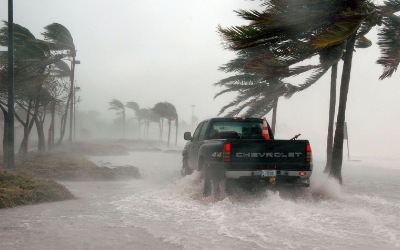
Experts are warning that Hurricane Florence may the strongest to hit the Carolinas and Virginia in years. Florence currently sits in the Atlantic as a Category 4, but forecasters are predicting that it could intensify to a Category 5 later today and will make landfall later in the week. Some US weather agencies are predicting that Hurricane Florence will stall, creating a prolonged heavy rainfall event, affecting not only the coast, but inland cities and towns as well.
More than one million residents of South Carolina and North Carolina are under mandatory evacuation orders, with many more being urged to evacuate from at-risk areas. Mandatory evacuation orders are in place in some coastal areas of Virginia as the storm approaches.
While packing emergency supplies for your family, it is important to plan and pack for your pets as well. Leaving your pet behind, expecting to come back later, is just not wise – chances are you won’t be able to return home to retrieve your pet or your pet’s belongings.
The following is a list of items to take with you to ensure you have the essentials for your pet:
- Crate or carrier. Not only is it easier to evacuate with your pet securely held in a crate or carrier, once at the evacuation center, your pet may be overwhelmed by the noise and commotion of so many people and pets. Provide a favorite blanket or bedding and throw a few favorite toys into the crate. Having a comfortable, familiar, and safe spot to rest will help alleviate some of the stress your pet may experience.
- Pack kibble in Ziploc-style bags or pack canned food. Take enough food to last at least one week. If you pack canned food, be sure to pack a can opener!
- Bottled water. Municipal water supplies may become contaminated with raw sewage or other contaminants that could make your pet (and you) ill. Cooled boiled water will kill most bacteria but will not destroy chemicals such as pesticides that may make their way into the water supply. Dogs need about 8-17 ounces of water per ten pounds body weight per day, and cats need slightly less. In other words, a 65-pound dog will drink between ¼ – ½ gallon of water daily. Keep in mind that in extreme heat and humidity, these needs may rise. Bottom line: having more water is better than not enough.
- Food and water dishes. The evacuation center may not have food and water dishes available, so be sure to pack dishes or containers that your pet can use.
- Pack all medications and preventives your pet needs, especially those that are vital to your pet’s well-being. You won’t know when it will be safe to return home, so be sure to have enough packed for at least a week.
- Litter box and litter. Your cat(s) will naturally need a place to eliminate, so having a litter box and a bag of litter is essential. A disposable aluminum roasting pan can work in a pinch!
- Waste bags. Be sure to have pet waste collection bags packed to pick up after your pet.
- Paper towels, liquid soap, hand wipes, and garbage bags. Cleanup in evacuation centers can be challenging. Be sure to have your own supplies on hand to help keep your area and your pet clean.
- Basic pet first aid kit. Pack a first aid kit. Include gauze pads, cotton swabs, self-cling bandages that won’t stick your pet’s fur, antiseptic wipes, sterile saline solution, disposable gloves, petroleum jelly, and a thermometer. A basic pet first aid book is great to have on hand.
- It is important to have a copy of your pet’s microchip number in case you become separated from your pet.
Do not leave your pets behind! Conditions can change quickly, and you may not be able to return home to get them. Stay safe and give your pets lots of cuddles during this challenging and stressful time.